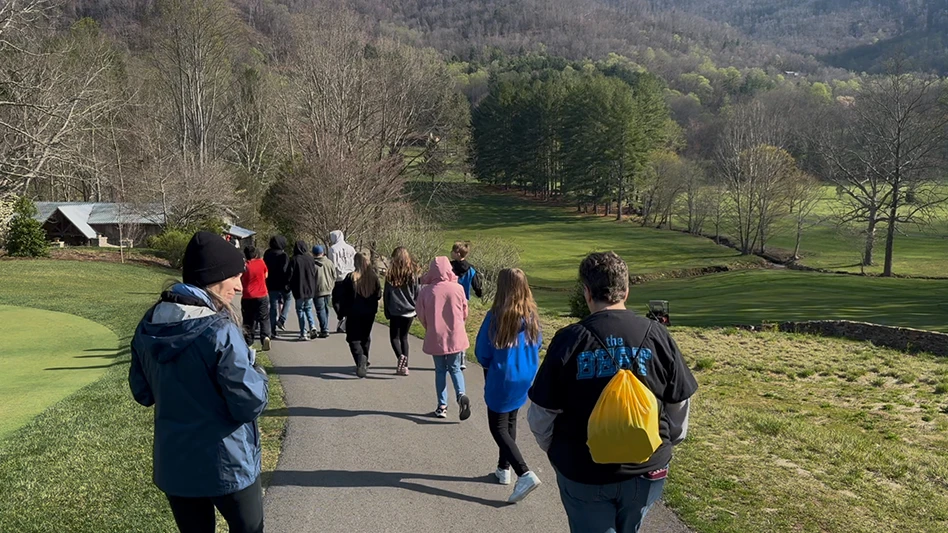
There are bound to be extremes when it comes to golf course irrigation. While one superintendent may track every drop of water and measure the system’s efficiency, another may just flip the switch and allow the water to fall where it may. The majority, though, fall somewhere in between.
Most superintendents know that optimal moisture levels lead to better turf conditions, but many don’t know what the “optimal” level is, says Carmen Magro, CGCS, vice president, business development/chief agronomist at Stevens Water Monitoring Systems. Magro has been a superintendent in the Mid-Atlantic region and the director of the Golf Course Turfgrass Management Program at Penn State University. He later founded Agronomy Management Solutions – an international agronomy consulting firm – that eventually merged with Stevens Water Monitoring Systems.
“At the very least, we use our eyes and fingers to see and feel what kind of moisture is in the turf,” Magro says. “Over time, we learn that when we have a certain feel of moisture, we can anticipate a certain turf condition. Moisture, however, impacts not only turf health, but its performance at the surface for the game of golf and player satisfaction.” Magro stresses “touch and feel” should not be the minimum standard for today’s superintendent.
Ian H. Williams, national specification manager for Rain Bird’s Golf Division, has seen both extremes from golf course maintenance crews. In fact, he’s known superintendents who chose not to use any data and simply irrigate their courses for a certain amount of time.
“In my experience, that almost always leads to overwatering, which not only affects water bills and budgets, but can also lead to unhealthy turf,” he says.
On the flip side, Williams also knows superintendents who keep a close eye on irrigation data, and who monitor soil temperature and volumetric water content and analyze those trends over six- to 12-hour periods.
“Simply by measuring and evaluating that data, these (data-minded) individuals are able to make proactive decisions,” he says. “That information helps them understand how their turf is going to react based on the forecast and the trending sensor data.”
And the misperception that “healthy” means “high performance” is one mistake Magro sees a lot of superintendents make. For example, the more a turf looks “off” or stressed, the better it performs for the game. This is a difficult concept to understand for trained superintendents and players alike.
“The only way one can understand what the limitations and impacts of water are on the turf’s performance is through precision monitoring,” he says. “Only when monitoring is in place to measure moisture as the turf sees it can one understand the short- and long-term impacts of moisture changes. Otherwise, we are responding to what we see and that often is a little too late.”
Consider three-day blocks when dealing with extreme water situations, Magro says. Turfgrass tends to respond to shortages or excessive amounts of water in cycles of about 72 hours. While a superintendent can see a drought impact fairly quickly by way of footprints or discolored, laid over turf, the setback from that drought condition will last a few days.
“If the turf is holding too much water, the impacts on air exchange and disruption of plant cell division will also last a few days,” Magro says. “Further, there is now evidence that maintaining a consistent moisture level will reduce the appearance of certain disease symptoms like fairy ring, where managing moisture with high and low levels without consistent moisture levels will lead to more fairy ring appearance on the same turf plot.”
If you’re not monitoring water usage on our course then you should begin to do so, says Brian Vinchesi, President of Irrigation Consulting, with offices in Massachusetts, North Carolina and New Jersey. At a minimum, Vinchesi says superintendents should meter and track all of their water use, including any wells, potable water, pump station and pumping flows
“If you do not measure water use, you cannot manage your water use,” Vinchesi says. “If your state requires a water-withdrawal permit, then you probably already meter your water as it has to be reported. If your state doesn’t, it is a good idea to measure, so when permitting becomes a reality, then it is better to be able to tell the state how much water you use as opposed to the state telling you how much you can use.”
Begin by investigating how colleagues in your market use water and what their minimum standard of gauging water use is, says Williams. Start by asking how they are irrigating and what the results have been, then talk to your local golf irrigation distributor. Distributor personnel have years of experience and are a resource when it comes to watering trends and maximizing the equipment you already own and operate. “Distributor personnel are also familiar with other courses in the area and what has been successful and not successful,” Williams says.
Eric Bauer, director of agronomy at Bluejack National in Montgomery, Texas, tracks irrigation and watering trends monthly and verifies their actual usage compared to the projected irrigation flow. “Today’s irrigation software has more than enough reporting information for any turfgrass manager to fully understand any trends that are being done with watering,” Bauer says. “It just takes commitment from the superintendent to review and adjust watering that need to be adjusted.”
Minimally, superintendents should employ the use of a portable precision monitoring system that not only gives information of real-time moisture and other key variables that impact, not only moisture, but the availability of nutrients and the need for cultural practices, Magro says.
“The cost of this investment is minimal compared to the impacts of lost play, unhappy players, lost turf, lost sleep and wasted resources including water, power, nutrients and labor,” he says. “The thought that touch-and-feel is ‘old school’ is a non-argument, as this is naturally what every superintendent and turf manager should be doing anyway.
“Even with monitoring, we still have to correlate what we see and feel with what the monitoring tells us,” Magro adds. “The big difference is to visualize and predict how the turf will respond before we ever see symptoms … bad or good. That is what monitoring brings to the game … pertinent information, better decisions, better responsibility.”
Conversely, irrigation monitoring is not merely about collecting data, Magro says. Many tools provide a number quickly without any thought to how that number was ascertained or what it means. “Beyond the minimum of collecting information is doing something with it,” he says. “Visualizing it to understand how one part of one green needs different attention than another part of the same green. Or how one green needs different management compared to another green on the same property. Making ‘global’ or course-wide decisions has now become a poor way of making decisions.
And Magro balks at the term “extreme,” which he says makes collecting copious amounts of data sound like T.M.I. ... too much information. “Nothing is over the top when it comes to collecting key data properly and using it wisely to make decisions,” he says. “In my travels as a consultant to operations around the world, I cannot tell you how many times I have come to a facility to find binders full of data from soil and water analysis labs, nutrient analyses and physical evaluations of turf systems, yet the management of the facilities does not follow a lick of information out of those reports.”
And the availability of turf data – in addition to irrigation – is only becoming more prevalent for turf managers. Williams says the industry is already getting a glimpse at what’s ahead.
“Soil sensors are available today and provide detailed data directly from turf root zones,” he says. “Following trends in the soil over 12 hours of time and understanding the plant’s relationship to certain soil conditions, including high temperature, can help superintendents be more proactive when managing irrigation.
“It sounds very futuristic, but drones are now able to map plant moisture levels and health using hyperspectral imagery,” Williams adds. “This same technology will be available from satellites with the same level of detail. While a drone fly-over provides a once-a-day snapshot of conditions, permanently installed soil sensors can offer around-the-clock data that superintendents and their staff can easily compile into meaningful trends at any minute.”
Many still consider monitoring a luxury or high-budget product or tool, however, this could not be farther from the truth about using advanced monitoring technology, Magro says. In fact, he’s witnessed more average or low-budget properties using the system in regions of the world that one would have originally thought would never use such a technology. In other words, there is no direct correlation between budget and those using this technology.
“This is a direct sign that using technology is fast becoming a staple application,” Magro says. “Staple … meaning it will be very hard to find a property without it sooner rather than later. Technology has proven that, on average, even the best, most successful turf managers have room to reduce water, nutrients, power and related applications on their properties. Even those users that still tend to use technology to only justify what they are already doing will soon learn, if not already, that they are not making the best decisions all of the time.”
Increased availability and use of technology may be the future of irrigation data management, but there are steps all superintendents can take right away. That said, it’s not a quick fix.
“Changing conditions and tolerance levels in turf and throughout your property takes time,” Magro says. “It is not like a switch where it is either right or wrong. It is more about transitioning to levels the turf can adapt to over time and resulting in using the least amount of water, power and nutritional inputs as possible. It is about making the right decisions for labor-intensive cultural practices on areas that need it, when they need it, to avoid going over the edge or limiting key performance indicators in turf performance. It is about predicting what will happen if we push the turf one way or another. The only way one can know these things is by proper monitoring routinely and appropriately using the proper equipment, methods and analysis for better decisions.”

Explore the August 2018 Issue
Check out more from this issue and find your next story to read.
Latest from Golf Course Industry
- From the publisher’s pen: Watery dilemma
- The Aquatrols Company hires marketing manager
- Renovating Bredemus in West Texas
- Renovation starts at Okatie Creek GC at Sun City Hilton Head
- The Fittest Podcast in Turf: Episode 1
- New 6-hole course debuts in Oklahoma
- GCSAA announces Grassroots Ambassador Leadership Award recipients
- Reel Turf Techs: David Gummo





